





Most nut trees are too large to grow more than one or perhaps two in a home fruit and nut garden. However, a few familiar (and some unfamiliar) nut trees are suitable, depending on your climate zone. Almonds, cashews, filberts (hazelnuts), pine nuts and pistachios are some of the well-known smaller nut trees.
All around the world we celebrate today, April 22, as Earth Day, and it is a perfect time to consider planting trees with edible fruits and/or nuts here on our lovely blue planet. If your planting space is small, here are some smaller nut tree suggestions. The dwarf siberian pine with edible pine nuts grows only to about 9 feet tall. A few of the smaller nut producers are actually more of a bush, like the Allegheny chinquapin, and some filberts (hazelnuts) make a great hedge, providing nuts for both you and the wildlife. There are some hybrid nut trees that will bear fruit in as little as 3 years, unlike the large walnuts and butternuts which take at least 10 years to fruit.
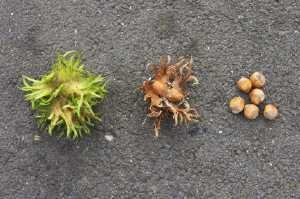

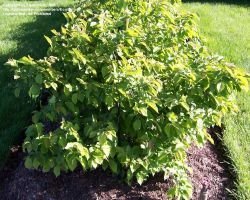 Stages of hazelnuts
Stages of hazelnutsOne of the best edible filberts is the European filbert, growing to about 15 feet tall. It thrives in cool, moist climates but is susceptible to winterkill. Here are a couple of filberts from PlantFiles: purple-leaf filbert (Corylus maxima 'Purpurea'), zones 6 to 10. Hazelnut (Corylus americana) is a small hedge bush, native to the eastern U.S. Two plants are needed to set fruit and they can grow to 8 feet or more. They grow in zones 5 to 8 and their nuts ripen in August. The fruits are edible although often left for wildlife. The wild filberts in the eastern United States often carry Eastern filbert blight, a fungal disease. You should not plant European filberts if eastern wild filberts are growing close by. The wild western filberts do not seem to carry the disease.
Almonds (Prunus dulcis) are a stone fruit like peaches, but you eat the nut. Grown in zones 8a to 10b, they are produced commercially in California in the valleys where it is drier. Cross-pollination is required (hence the rental of honeybee hives by commercial groves). Raintree Nursery lists 'Reliable' as an almond that is easily maintained at about 12 feet tall, and is self-fertile. It is not a true almond, but a hybrid seedling of peach and almond for zones 5 to 9. There is an edible ornamental almond (Prunus amygdalus) said to grow 12 to 20 feet tall, bears in 3 to 4 years, is disease-resistant and self-fertile. Two varieties I have seen advertised are 'Titan' and 'Halls Hardy'.
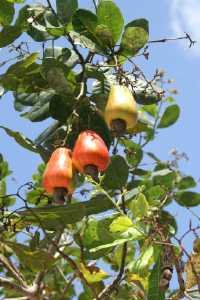
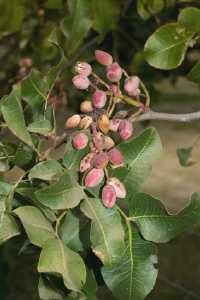 Cashew 'apples' with nuts
Cashew 'apples' with nutsCashew (Anacardium occidentale) is a fast growing evergreen tropical nut tree growing to a height of 30-plus feet. They are very susceptible to frost. Both the “apple” and the nut growing from the end of it are edible, and they contain five times the vitamin C of oranges. Pistachios (Pistacia vera) originated in Western Asia, where they are used in a variety of dishes; we probably know baklava best. The pistachio tree grows to 20 to 30 feet tall in zones 7a to 10b. They do well in the deserts if they are irrigated and have good drainage, but do poorly in high humidity and are subject to root-rot without good drainage. A male and a female are needed for fruit production.
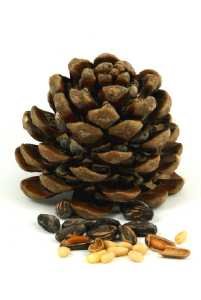 Pine cone with edible nuts
Pine cone with edible nuts
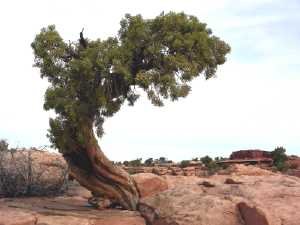
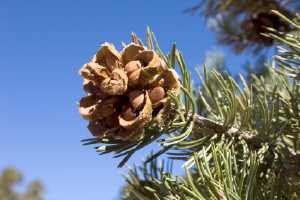 Piñon (Pinus edulis) Piñon cone with nuts
Piñon (Pinus edulis) Piñon cone with nutsPine nuts… oh my, there are so many… and they have been a food source for so long! Over 20 pine species produce edible pine nuts and of those, 5 are commercially important: Siberian pine (Pinus sibirica), Korean pine (Pinus koraiensis), Italian Stone Pine (Pinus pinea), Chilgoza pine (Pinus gerardiana) and singleleaf pinyon (Pinus monophylla), Colorado pinyon (Pinus edulis) and other pinyon (or piñon) species. The Korean Nut Pine is very hardy, tolerates clay soil, is resistant to white pine blister rust; and is a slow grower of medium height in zones 4 to 7. The Italian Stone Pine is not as winter hardy but it tolerates drought and heat better. It is the classic umbrella-shaped pine, said to grow in zones 7 to 9.[1] Many of the edible pine nut trees also make great ornamentals.
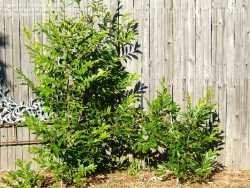
One small nut tree I have on my list to order is the Allegheny chinquapin (Castanea pumila), which is basically a shrub or dwarf tree growing 12 to 15 feet tall in zones 3 to 9. The nut tastes similar to the native chestnuts that were wiped out by the chestnut blight beginning in 1912. It is said to have a more flavorful taste than the modern chestnut hybrids. There is another small chinquapin, the Georgiana chinquapin (Castanea alnifolia), which is more of a creeping 4-foot tall shrub that grows in zones 8 to 10. The Allegheny chinquapin prefers neutral soils, preferably somewhat uphill, and develops a taproot. The Georgiana chinquapin prefers shady, sandy thickets and spreads by very large, underground, shallow roots. Both produce numerous sweet nuts on the female trees, and a male is needed for pollination.
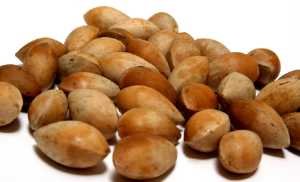
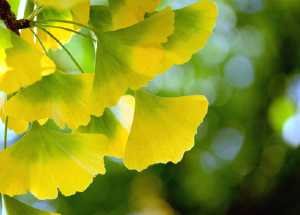 Ginkgo nuts
Ginkgo nutsAlthough not small trees, there are some visually interesting trees we don’t generally think of for edible nuts. Those include ginkgo (Ginkgo biloba). Ginkgo, also called maidenhair tree, is the oldest broad-leafed tree on earth, with existing fossils 150 million years old. They grow to 50 to 80 feet tall and are grown in zones 3 to 9 although they do better in zones 4 to 7. They need a male to pollinate the female for fruit, and it can take up to 10 years to produce the first fruits. The 1-inch nuts are stir-fried or roasted and are prized in Chinese, Japanese and Korean dishes. They are also among the few nut trees that are not affected by pests or disease.
Another unfamiliar nut tree is the Monkey Puzzle tree (Araucaria araucana), which is an very sculptural looking tree. It is native to Chile and hardy to -10ºF, or zones 6 to 9. This evergreen tree is not self-fertile so you will need 2 to produce nuts. The 2-inch long nuts are grown on a large cone with as many as 250 nuts per cone. The nuts can be roasted and eaten like chestnuts, or dried and ground for use as a nut flour.
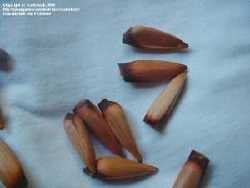
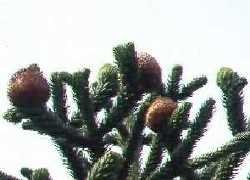 Monkey Puzzle nuts
Monkey Puzzle nutsNuts are an excellent source of protein, averaging from around 20% to as much as 75% in butternuts. Most nuts also have a high fat content although most of the fat is polyunsaturated. Nuts also contain Vitamin E, many of the B vitamins, and some essential minerals like zinc and magnesium. Almonds are a good source of calcium. Nuts are also low glycemic so they break down slowly and do not cause a surge in insulin levels.
End Notes
[1] Pinenuts: Species, Products, Markets, and Potential for U.S. Production, Leonid Sharashkin and Michael Gold, University of Missouri Center for Agroforestry,
Photo Credits
Almonds on branch, iStockPhoto #4632901, used by permission
Ginko Nuts, iStockPhoto #1137307, used by permission
Ginko leaves, iStockPhoto #4794604, used by permission
Hazelnuts, iStockPhoto #4215418, used by permission
Piñon tree, iStockPhoto #1505385, used by permission
Piñon with nuts, iStockPhoto #3658859, used by permission
Pistachios on tree, iStockPhoto #4731667, used by permission
Cashews on tree, iStockPhoto #2769754, used by permission
Pine-cone nuts, iStockPhoto #2675140, used by permission
Baklava, public domain
American Hazelnut, Thanks to Equilibrium for her photo from PlantFiles
Allegheny chinquapin, Thanks to AYankeeCat for use of her photo
Monkey Puzzle Nuts: Thanks to Gustichock for the photo from PlantFiles
Copyright © www.100flowers.win Botanic Garden All Rights Reserved